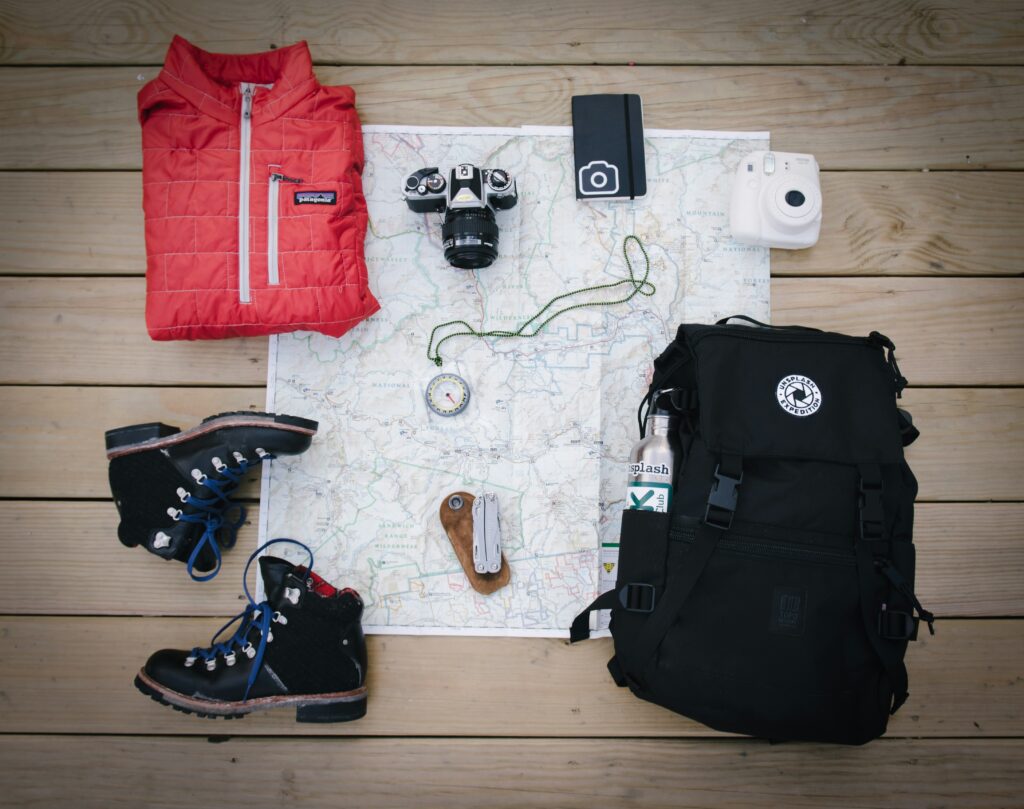Packing Essentials for Long-Term Travel

It's simple to pack for a weekend getaway—sling some stuff in a bag and go. However, when your stay is weeks or months, the packing becomes an exercise in strategic planning that will have a significant bearing on the quality of your travel experience. Long-term travel calls for a delicate balance between being well equipped for every eventuality and avoiding overpacking.
Regardless of whether you are planning a digital nomad journey on several continents, a sabbatical to explore a certain region, or a working holiday of some nature, meticulous packing will increase your mobility, reduce stress, and save you money.This blog presents tried-and-true methods from long-term travelers who have mastered the art of living well from a suitcase or backpack.
The subsequent sections will lead you through a packing plan considering your clothing versatility, technology needs, hygiene and health needs, and the too-often-overlooked psychological considerations of owning less. We'll also discuss some special considerations with respect to style of travel, climate, and destination in order to allow you to tailor your packing plan appropriately.
The Mindset: Less is More
Prior to delving into the various categories of individual packing, one should embrace the "less is more" philosophy espoused by seasoned travelers. Here's why traveling light transforms the long-term travel experience:
Benefits of Minimalist Packing
- Enhanced mobility: Navigate public transportation, crowded streets, and unexpected terrain with ease
- Reduced fees: Avoid checking bags on flights and exceed weight restrictions on buses and trains
- Simplified decisions: Fewer clothing options means less decision fatigue each morning
- Simpler planning: Track personal items in temporary housing
- Flexibility: Leave room for items you'll acquire on the way
- Safety: Have your high-value items in plain view always
Breaking the "Just in Case" Habit
The biggest obstacle to efficient packing is the "just in case" habit—packing for highly unlikely circumstances. Ask each potential item these questions:
- What's the actual probability I'll use this?
- How difficult would it be to locate this item at my destination if need be?
- What's the consequence of not having this item immediately available?
- Is there something else in my pack that can serve the same purpose?
Remember: In most destinations, you can purchase what you need locally, typically less expensive than at home. This tactic also provides authentic shopping experiences and supports local economies.
Clothing Strategies
Clothing tends to occupy the most volume in bags, so it's optimized first. The secret is to establish a travel wardrobe that is multipurpose according to these principles:
The Layer System
Rather than packing bulky stand-alone pieces, focus on layers that can be layered and combined according to weather:
- Base layers: Drying, wicking materials that sit next to the skin
- Mid layers: Insulating pieces like lightweight sweaters or fleece
- Outer layers: Weather-proof shell against rain or wind
This approach works whether you're traveling between different climates or experiencing day-to-day temperature fluctuations in the same location.
The Magic Number: One Week's Worth
Regardless of how long your trip is, attempt to pack one week's worth of clothes. This provides adequate variety while accommodating normal laundry cycles:
- 5-7 sets of underwear
- 3-5 sets of socks
- 3-4 tops/t-shirts
- 2-3 long-sleeve items
- 2 skirts/pants
- 1 pair of shorts
- 1 dress/nice outfit for formal events
- 1 light jacket or sweater
- 1 packable rain jacket or windbreaker
Material Matters
The fabric of your clothing makes a huge difference in both comfort and convenience:
- Merino wool: Excellent for temperature control, odor management, and comfort across the climate. Worth the cost on important items like socks and base layers.
- Quick-dry synthetics: Must-haves for damp climates and heavy hand-washing
- Wrinkle-resistant fabrics: Stay polished without the ironing
- Don't go for 100% cotton: It's heavy, slow to dry, and clings to odors
Smart Accessories
Accessories can dress down plain clothes and be applied in other cultural contexts:
- Multi-tasking scarf: Sunscreen, modest cover for churches, spontaneous picnic blanket, pillow on road trips
- Compressible daily pack: Packed small but expands for daily excursions
- Buff/neck gaiter: Serves as headband, face mask, eye mask, and more
Footwear Philosophy
Footwear occupies a significant amount of luggage space, so discrimination is necessary:
- Walking shoes: Tough enough for day-long exploration, but stylish enough for evening restaurants
- Flip-flops/sandals: For beach, suspicious showers, and tropical conditions
- Optional third pair: Activity-specific (hiking boots, dress shoes) based on your itinerary
Tip: Carry your bulkiest shoes on travel to minimize space taken up by them in luggage.
Technology and Connectivity
Technology enables work, navigation, communication, and recording experiences for the new traveler:
Must-Have Tech
- Smartphone: Your go-to navigation, translation, communication, and photo tool
- Universal power adapter: With a number of USB ports to cut down on outlet use
- Portable battery pack: Minimum 10,000mAh capacity for complete phone recharges
- Headphones: Preferably noise-canceling for travel and focused work
- E-reader: For voracious readers, an e-reader weighs a fraction of books
Digital Nomad Additions
If working remotely:
- Laptop and protective case
- Portable laptop stand for ergonomic work areas
- Wireless keyboard and mouse small if using laptop stand
- Very small HDMI cable for presentations or for plugging into TV screens
Connectivity Solutions
- Local SIM card: Usually best value for data in each country
- SIM service: Convenient but usually more expensive than physical SIMs
- Portable WiFi hotspot: Only worth it for countries with bad connectivity or working on several devices
Health and Hygiene Essentials
Planning for staying healthy and clean when traveling long-term requires strategic thinking:
Medical Kit Essentials
- Personal medication: Take spares with prescription copies written in generic terms
- First aid essentials: Bandages, antiseptic wipes, blister care
- Common medications: Pain reliever, anti-diarrheal, antihistamine, motion sickness medication
- Rehydration salts: Necessary for food poisoning recovery or in warm climates
Toiletries Strategy
- Solid products: Soap bars, soap, and solid deodorant save room and avoid liquid restrictions
- Refillable containers: 100ml containers for essentials, refilled from local stores
- Multipurpose products: Soap for body, laundry, and dishes
Special Considerations
- Prescription glasses: Bring backup pair and copy of prescription
- Menstrual products: Use reusable products such as menstrual cups or period underwear
- Contact lenses: Work out supply required or opt for glasses for the journey
Documents and Financial Readiness
Proper documentation prevents headaches and provides a feeling of relief:
Document Checklist
- Current passport with at least six months' validity beyond the end date of the trip
- Digital and paper copies of passport data page
- Visas required or evidence of visa entitlement
- International driving permit if intending to drive abroad
- Evidence of travel insurance and policy information
- Vaccination records (including COVID-19 records)
Financial Preparation
- Multiple payment methods: Two credit cards on different systems
- Emergency USD/EUR cash
- Secret storage location for cards and cash
- Internet banking apps that enable international transfers
- Warning banks to travel plans
Packing Organization Systems
How you pack is almost as important as what you pack:
Compartmentalising
- Packing cubes: Transform messy luggage into organized systems, compression schemes save space
- Stuff sacks: Lightweight organizer for small items
- Electronics pouch: Store cords, adapters, and accessories
Access Prioritization
Prioritize contents by frequency of use:
- Daily essentials: Top bag or outer pockets
- Occasional items: Middle pockets
- Emergency or seldom used items: Bottom of bag
Destination-Specific Considerations
Tailor your packing plan to your destination's unique circumstances:
Climate Variations
- Tropical destinations: Emphasize moisture-wicking, quick-drying fabrics and sun protection
- Cold weather: High-quality base layers and compact insulation layers
- Mixed climates: Emphasize the layering system and multi-use pieces
Cultural Sensitivity
Research local dress code and cultural customs:
- Conservative regions: Unobtrusive, shoulders, knees, hair sometimes covered
- Religious sites: Specific entry requirements (head coverings, long pants/skirts)
- Business cultures: Suitable attire for professional settings where applicable
Urban vs. Rural Travel
- Urban travel: Emphasize style-versatility and theft protection
- Rural/adventure travel: Durability, weather resistance, and technical capabilities
Long-Term Travel Tips
These insider tips can turn your long-term travel experience:
Laundry Solutions
- Portable washing line: Braided elastic minimal space
- Sink stopper: One-size-fits-all fits most hand-wash drains
- Laundry soap sheets: Lightweight versus liquid detergent
- Quick-dry underwear: The staple of everyday hand-washing routine
Comfort Enhancers
- Sleep mask and earplugs: Muffle noisy hostels and bright rooms
- Packable down pillow: Travel-sized luxury for improved sleep quality
- Smartphone white noise app: Establish consistent sleep environment
- Compact spice kit: Introduce variety to monotonous food
Security Measures
- Luggage locks: TSA-approved for checked bags, regular for lockers
- Money belt or hidden pocket: Passport and emergency funds
- RFID-blocking wallet: Protect against electronic theft
- Carabiner clips: Bag to immovable objects on trains or cafes
What to Leave Behind
Understanding what not to bring is equally important as understanding what to bring:
Common Overpacking Mistakes
- "Just in case" clothing: Dressy pieces, excessive cold-weather gear
- Full-size toiletries: Found everywhere in the world
- Heavy guidebooks: Use digital versions
- Specialized gear: Unless central to your travel purpose
- Sentimental things: Leave irreplaceable items behind
Mental Baggage
Besides material possessions, consider emotional preparedness:
- Perfectionism: Accept that you'll leave something behind—and cope
- Anxiety over things: Practice letting go of material attachment
- Scarcity fear: Trust your resourcefulness and local availability
Conclusion
Learning the art of packing for extended travel isn't so much a matter of shoving stuff into a sack—it's an embracing of lifestyle that prioritizes experience over objects. The world's most advanced travelers have the luxury of light travel, in that they understand that whatever convenience they lose, they gain by way of liberty, simplicity, and receptiveness to new experience.
As you plan your trip overseas, remember that packing is a task that is based on each individual trip. Your very first long-term travel adventure will reveal what you actually need for your unique needs and method of travel. Be willing to adapt, refine your packing list, and send things back home periodically or give away what is not working for you.
Ultimately, the most essential items that you'll be lugging around are not physical possessions but the attitude of curiosity, flexibility, and perseverance that marks successful long-term travelers. Pack smart, pack light, and focus your efforts on piling experiences rather than babying possessions. Your road-worn future self will thank you for every ounce you don't carry.















